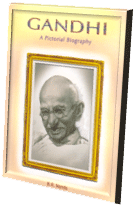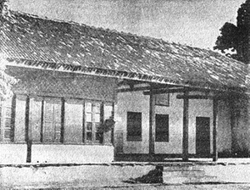
P.O. SEVAGRAM, DIST.WARDHA 442102, MS, INDIA. Phone: 91-7152-284753
FOUNDED BY MAHATMA GANDHI IN 1936
BIOGRAPHY OF GANDHI
GANDHI - A PICTORIAL BIOGRAPHY
by Shri B. R. Nanda

GANDHI
- A PICTORIAL BIOGRAPHY
Shri B. R. Nanda
Table of Contents
- About Gandhi
- Childhood
- Off To England
- Briefless Barrister
- In The 'Dark Continent'
- The Young Politician
- Satyagraha Struggle In South Africa
- The Making Of The Mahatma
- Return To India
- Gandhi's Ashram
- World War I
- Rowlatt Bills
- Nonviolent Non-cooperation
- Arrest And Imprisonment
- Reaction And Recovery
- Declaration Of Complete Independence
- Gandhi-Irwin Pact
- Round Table Conference
- In London
- Resumption Of Struggle
- Campaign Against Untouchability
- A New Deal For The Village
- The New Constitution
- Hindu-Muslim Antagonism
- Nonviolence In A Violent World
- Cripps Mission
- "Quit India"
- Simla Conference
- Cabinet Mission
- Communal Conflagration
- Partition of India
- Mission of Peace
- The End
- Gandhi and Nonviolence
About This Book
This is the first pictorial biography of Gandhi in which the narrative-concise, readable and incisive is illustrated with contemporary photographs and facsimiles of letters, newspaper reports and cartoons, adding up to a fascinating flash-back on the life of Mahatma Gandhi and the struggle for Indian freedom led by him. There is a skilful matching in this book of text and illustrations, of description and analysis and of concrete detail and large perspective. This pictorial biography will revive many memories in those who have lived through the Gandhian era; it should also be of interest to the post-independence generation.
About Author
Shri B. R. Nanda - former Director, Nehru Memorial Museum and Library, New Delhi. His full-scale biography of Mahatma Gandhi has been published in India, Britain and the U.S.A. and translated into French, Spanish, Italian and several other languages
Chapter-9 : Gandhi's Ashram

While his political views were yet unformed, Gandhi's immediate problem was to settle the small band of relatives and associates in the South African struggle who had cast their lot in with him. He decided to found an ashram and locate it at Kochrab, a village near Ahmedabad. Later the ashram was shifted to a more permanent site on the bank of the river Sabarmati.
Gandhi once defined an ashram as "group life lived in a religious spirit". The word "religious" was used here in the widest sense. The ashram did not enforce on its inmates any theology or ritual, but only a few simple rules of personal conduct. Some of the vows administered in the ashram, such as those to truth, non-violence and chastity, were of universal application; others, such as those to eradicate untouchability, to do physical labour and to practise fearlessness were intended to meet the peculiar conditions of the Indian society, which was caste-ridden, discounted dignity of labour and was dominated by an alien government.
All these vows were to be observed in an intelligent and creative way. They were not intended to be mechanical formulae, but as practical aids to moral and spiritual growth. They may appear to be platitudes, but nevertheless they embodied ancient truths which were none the less valid for not having been realized by the common run of mankind in workaday life.
A mere enumeration of the vows is enough to indicate that life in the ashram was austere. It was also busy. Everyone had to put in some manual work. There was a spinning and weaving department, a cowshed and a large farm. Every inmate of the ashram cleaned his own plates and washed his own clothes. There were no servants. The atmosphere was, however, not so much of a monastery but that of a large family under a kindly but exacting patriarch. Gandhi was Bapu, the father of the household, Kasturba was Ba, the mother. It was a motley group including little children and octogenarians, graduates of American and European universities and Sanskrit scholars, devout whole-hoggers, and thinly disguised sceptics. It was a human laboratory where Gandhi tested his moral and spiritual hypotheses. It was also to him what the family is to most people, a haven from the dust and din of the world. It was a family linked not by blood or property, but by allegiance to common ideals. Gandhi ruled the ashram but his authority in the ashram, as well as in the rest of the country, was moral. When things went wrong or a member of the ashram was guilty of a serious lapse, Gandhi would take the blame upon himself and atone for it by undertaking a fast.